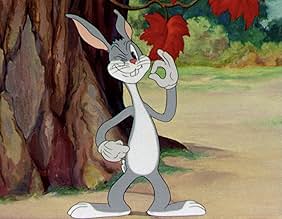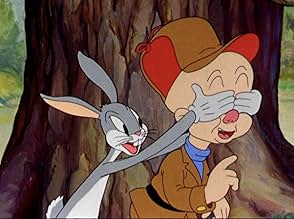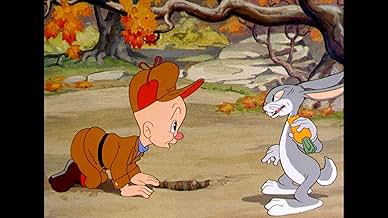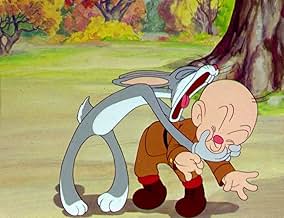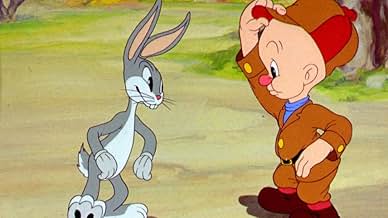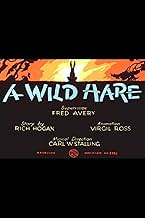Agrega una trama en tu idiomaWhile hunting rabbits, Elmer Fudd comes across Bugs Bunny, who tricks and harasses the hunter.While hunting rabbits, Elmer Fudd comes across Bugs Bunny, who tricks and harasses the hunter.While hunting rabbits, Elmer Fudd comes across Bugs Bunny, who tricks and harasses the hunter.
- Dirección
- Guionista
- Elenco
- Nominado a 1 premio Óscar
- 2 nominaciones en total
Mel Blanc
- Bugs Bunny
- (voz)
- (sin créditos)
- …
Arthur Q. Bryan
- Elmer Fudd
- (voz)
- (sin créditos)
- Dirección
- Guionista
- Todo el elenco y el equipo
- Producción, taquilla y más en IMDbPro
Opiniones destacadas
Compared to the first (two) appearances of the developing Bugs, this is very funny, has characters with incredibly developed plots and indeed is better quality. I find because the humour of "Porky's Hare Hunt" and "Prest-O Change-O" are very old-fashioned and not very understandable for today's humour (although I still found "Porky's Hare Hunt" quite funny). This episode feels much more like it was made recently, even though it was made only two or three years after the developing Bug's first appearances. In this, apart from his deeper voice, he feels much more like the Bugs Bunny we know today.
I also like this episode for the very sweet first Elmer featured, Bugs Bunny is very entertaining and there is nice animation included. I have to say in this, Bugs Bunny reminded me a lot of Br'er Rabbit, which was comforting (HE didn't make his first appearance for nearly ten years after!!).
The plot is very much like the average episode with Elmer and Bugs. Elmer is hunting for "wabbits" and he finds Bugs. Many of the gags have been repeated many times in more recent episodes, but are still funny none the less. There are some other gags added which are funny.
I recommend this episode to enthusiasts of early Looney Tunes (but still like gags which are repeated in modern Looney Tunes episodes) and who like Bugs Bunny. Enjoy "A Wild Hare"!
I also like this episode for the very sweet first Elmer featured, Bugs Bunny is very entertaining and there is nice animation included. I have to say in this, Bugs Bunny reminded me a lot of Br'er Rabbit, which was comforting (HE didn't make his first appearance for nearly ten years after!!).
The plot is very much like the average episode with Elmer and Bugs. Elmer is hunting for "wabbits" and he finds Bugs. Many of the gags have been repeated many times in more recent episodes, but are still funny none the less. There are some other gags added which are funny.
I recommend this episode to enthusiasts of early Looney Tunes (but still like gags which are repeated in modern Looney Tunes episodes) and who like Bugs Bunny. Enjoy "A Wild Hare"!
It is very hard to review "A Wild Hare" on its own solo merit after the sixty-plus years that followed and thus turned its central character into the biggest cartoon character ever. In comparison to the subsequent films that appeared until 1964, this very first official entry is tame but still a wonderful model for those that followed.
Let's say this was 1940 and If I saw this cartoon for the first time ever with absolutely no knowledge of Bugs Bunny, I would say that "A Wild Hare" alone is a fine cartoon, in which the hunter becomes the heckled. The prey is a slick "wabbit" character that starts in on him at the very beginning, knocking on the wisping hunter's bald head to get his attention.
It is no wonder that this cartoon is directed by Fred Avery, who only three years ago directed a similar cartoon called "Porky's Duck Hunt," in which Porky's prey evolved into the current Looney Tunes star Daffy Duck. Should we be keeping our eyes on this "wabbit?"
Let's say this was 1940 and If I saw this cartoon for the first time ever with absolutely no knowledge of Bugs Bunny, I would say that "A Wild Hare" alone is a fine cartoon, in which the hunter becomes the heckled. The prey is a slick "wabbit" character that starts in on him at the very beginning, knocking on the wisping hunter's bald head to get his attention.
It is no wonder that this cartoon is directed by Fred Avery, who only three years ago directed a similar cartoon called "Porky's Duck Hunt," in which Porky's prey evolved into the current Looney Tunes star Daffy Duck. Should we be keeping our eyes on this "wabbit?"
Here is Tex Avery's magnificent film in which we are first introduced to a brownish-gray colored hare named Bugs, although we really don't hear his name spoken in this film. Yet that immortal phrase, "What's Up Doc???" is here, and Bugs is a sly, bold, incredibly smart woodland creature outfoxing that "wovable" hunter, Elmer Fudd. No more wacky prototypes. Bugs is at last fleshed out the way he should be. I appreciate his "Dad" and "Grandpa" very much. Someone's dream wouldn't have come true without them and our star might never have been born without them. Nevertheless, the star is Bugs Bunny!!! And after this film, he was well on his way to becoming what he is today.
Thank you Tex Avery!!!
Thank you Tex Avery!!!
This is my third favorite cartoon, only beat by Invasion of the Bunny Snatchers and Duck Amuck. It manages to feel newer than the shorts where Elmer is fat, due to having Elmer's final design. It also has value that makes this based, introducing Bugs.
Rabbits were common in early animation such as in Walt Disney's 'Oswald the Rabbit.' But the king of all cartoon rabbits is Bugs Bunny. His first official appearance was in July 1940 "A Wild Hare,' co-starring Elmer Fudd as the hunter entrapped by Bugs Bunny's clever antics.
The Merrie Melody cartoon, drawn by the wizard artists at Leon Schlesinger Productions, was part of Warner Brothers distribution arm. The studio had introduced an earlier incarnation of Bugs in 1938's "Porky's Hare Hunt' featuring a frustrated Porky the Pig trying to shoot a clever and elusive rabbit. Four cartoons later of the pesky rabbit Bugs appeared in "A Wild Hare," directed by Tex Avery. Voice actor Mel Blanc employed his Bronx/Brooklyn accent to mimic the rabbit modern viewers are familiar. This is the first cartoon Bugs uses his catchphrase, "What's up, Doc?" Director Tex Avery claims he's the one who came up with the phrase from his days living in Texas where it was a commonly said. Mel Blanc, however, said he first ad-libbed the saying spontaneously in the narration booth, and everyone loved it.
Animator Bob Givens was assigned to redesign the previous rabbits into the basic look we see today as Bugs Bunny. Givens lengthened the rabbit's body, and has him standing straight up. There were a couple of attributes as to the origins on Bugs' habit chomping on carrots. One is the famous scene in 1934's Academy Award Best Picture winner "It Happened One Night" where Clark Gable munches on a carrot while Claudette Colbert exhibits her method of hitchhiking. Another is wise-cracking actor Roscoe Karns' character Oscar Shapely in the same movie, who was a big carrot fan.
Bugs Bunny appeared in over 160 cartoons between 1940 and 1964, and has been in more films than any other animated character. Bugs has a star on Hollywood's Walk of Fame and is Warner Brothers' official mascot.
The Merrie Melody cartoon, drawn by the wizard artists at Leon Schlesinger Productions, was part of Warner Brothers distribution arm. The studio had introduced an earlier incarnation of Bugs in 1938's "Porky's Hare Hunt' featuring a frustrated Porky the Pig trying to shoot a clever and elusive rabbit. Four cartoons later of the pesky rabbit Bugs appeared in "A Wild Hare," directed by Tex Avery. Voice actor Mel Blanc employed his Bronx/Brooklyn accent to mimic the rabbit modern viewers are familiar. This is the first cartoon Bugs uses his catchphrase, "What's up, Doc?" Director Tex Avery claims he's the one who came up with the phrase from his days living in Texas where it was a commonly said. Mel Blanc, however, said he first ad-libbed the saying spontaneously in the narration booth, and everyone loved it.
Animator Bob Givens was assigned to redesign the previous rabbits into the basic look we see today as Bugs Bunny. Givens lengthened the rabbit's body, and has him standing straight up. There were a couple of attributes as to the origins on Bugs' habit chomping on carrots. One is the famous scene in 1934's Academy Award Best Picture winner "It Happened One Night" where Clark Gable munches on a carrot while Claudette Colbert exhibits her method of hitchhiking. Another is wise-cracking actor Roscoe Karns' character Oscar Shapely in the same movie, who was a big carrot fan.
Bugs Bunny appeared in over 160 cartoons between 1940 and 1964, and has been in more films than any other animated character. Bugs has a star on Hollywood's Walk of Fame and is Warner Brothers' official mascot.
¿Sabías que…?
- TriviaThe producers' reaction to the gag of Bugs responding to a hunter pointing a gun at him with a confident casual remark, "What's up, Doc?" was so favorable that they decided to make that a standard element of future films featuring the character.
- ErroresAfter Bugs ties up Elmer's shotgun and Elmer throws it away he then starts digging. Bugs comes up from his other hole, saying his first time ever "Eh Whats up Doc?" then Elmer says "I am looking for a Wabbit". Bugs starts describing a rabbit and during a close up When Elmer realized Bugs is a rabbit he us holding the shotgun again, next panel it's gone again.
- Citas
[first lines]
Elmer Fudd: [first occurence of this line] Be vewy, vewy qwiet. I'm hunting wabbits.
- Créditos curiososIn the 1944 Blue Ribbon reissue of this cartoon, when the WB shield zooms in the copyright notice briefly says MCMXLIV(1944) for a fraction of a second before changing to MCMXL(1940)!
- Versiones alternativasWhen the cartoon was re-released as a Blue Ribbon re-issue, it was inadvertently retitled "The Wild Hare." Also, one of the names Elmer Fudd guesses was changed from Carole Lombard, who had recently died in a plane crash, to Barbara Stanwyck.
- ConexionesEdited into Bugs Bunny Superstar (1975)
- Bandas sonorasYankee Doodle
(ca. 1755) (uncredited)
Traditional music of English origin
Selecciones populares
Inicia sesión para calificar y agrega a la lista de videos para obtener recomendaciones personalizadas
- Which series is this from: Merrie Melodies or Looney Tunes?
- What four names does Elmer Fudd guess?
- List: Warner Bros. cartoons nominated for Academy Awards
Detalles
- Tiempo de ejecución8 minutos
- Mezcla de sonido
- Relación de aspecto
- 1.37 : 1
Contribuir a esta página
Sugiere una edición o agrega el contenido que falta

Principales brechas de datos
What is the French language plot outline for A Wild Hare (1940)?
Responda
